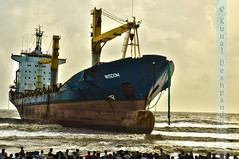Wednesday, September 21, 2011
BreathTaking place that I have seen recently
Wednesday, July 20, 2011
Thursday, May 26, 2011
New Camera... New Video
Nikon D 7000 Test Video from Kunal Deshpande on Vimeo.
Monday, April 18, 2011
Tuesday, April 05, 2011
A Being in Bhuj
A Being in Bhuj from Kunal Deshpande on Vimeo.
Portfolio Shot 1

Portfolio
Originally uploaded by Kunal Deshpande
This is a photograph from a recent portfolio I shot for a friend. There was a great sense of pleasure because I was returning to purely still photography after a long time of not doing anything constructive....
Monday, March 07, 2011
First Non Fiction Film From Kutch
Bhojraj Meghwal - Kutch craft films from Kunal Deshpande on Vimeo.
Monday, January 17, 2011
The Battleship Potemkin :
Battleship Potemkin : Dialectics & Socialist Realism:
- Kunal Deshpande
We will explore the Socialist Realism and Dialectics used in a 1925 film By Sergei Eisenstein, called Battleship Potemkin. For exploration of these two terms, we first need to understand what these terms mean. These two concepts are essential elements of Eisenstein’s body of work.
The term Socialist Realism means the kind of artistic expression that was used (especially in the Soviet Union) to forward the aims of socialism and communism. This was used largely in the Soviet Union after the end of the Tsarist period for propaganda of communism and the idea that everything was in the ownership of the proletariat (common people).
The concept of dialectics has its roots in communism and Marxism. The concept, in essence means that anything in this world (called the THESIS), comes into being with an opposite (called the ANTITHESIS). The conflicting nature of the Thesis and the Antithesis leads to a Synthesis, which is either an alternative remedy to the clash, or is an entirely different approach to achieving the desired result. According to Marxist Dialectics, the society is the thesis. The problems in society are the antithesis and the new social structure and form that emerges from the clash of the existing society and the problems is the Synthesis. This is an endless triangle of the clash between the thesis and the antithesis in society or economy, and the synthesis also has an antithesis and then leads to another synthesis and so on.
The film battleship Potemkin [N1] is a socialist realistic film, as has been said earlier. The film portrays how sailors on a ship by the name of the movie mutiny the autocratic and torturous leadership on the ship. This leads to a conflict in a town called Odessa where the people gather in large numbers to greet the ship, and they are indiscriminately fired upon by the Cossacks, who were the Tsarist guards. The struggle between the people and the Cossacks at the Odessa Staircase is what is going to be the focus of our study here. We will study the Soviet Socialist Realism used here along with the dialectic frames used by Eisenstein in the Odessa Staircase sequence. [N2]
THE ODESSA STAIRCASE:
The sequence of the Odessa staircase is the 4th act in the film, which is made of 5 parts or acts. [N3] The sequence begins with text telling the viewers that the town of Odessa was with the sailors (in spirit). The sequence then shows a lot many boats streaming toward the ship with food and supplies. Following this is the portrayal of many people standing on the massive staircase and waving out to the ship. Here, in one shot, there is a lady who looks well to do by her attire, which is a white gown, standing on the staircase with one foot on a higher step and one on the lower. The frame only shows her gown below the knees, with an umbrella touching the floor. There is a woman wearing a similar BLACK gown in the right mid edge of the frame. Between these two ladies, a disabled, haggard looking man comes into the frame from the right. This is an indicator that Eisenstein has used to establish the social stratification in Soviet Russia. This also indicates, according to Marxist / Hegelian dialectics, that the women and the man are the thesis and the antithesis, and that the class-driven clash will yield a classless society, which will be the synthesis. There is a very notable distinction between the attires of the ladies and that of the man, by which one can infer that the classes of these people are apart, but even then they are together in that space to greet the people controlled ship Potemkin?. This unison for the cause of the ‘control of the people’ is an example of Socialist Realism as it puts forth the idea of control being in the hands of the people, as important[N4] .
The next dialectic is found in the sub-sequence of the Cossacks shooting indiscriminately at the people gathered. Here, the framing and continuity editing used here is replete with dialectics and propagandist realism. The shooting begins with a woman’s mid shot, where she is shown to be screaming and writhing in pain as if somebody stabbed her in the back. The shot is taken from a low angle, letting the woman cover the whole frame. Then there is a shot where there is a statue pointing ahead, in the left of the frame, in the foreground. Below the statue, the Cossacks are marching toward the starting point of the massive staircase, slowly taking space in the frame. People are shown running away from them, on the staircase. The camera position gives the viewer a feeling of being in control, or being the higher authority as we look from a higher point of view, looking at the scene as something that is happening at a level below us. This is because of the framing and the mise en scene, which is the arrangement of elements in the frame to put forth what the filmmaker wants to convey to the viewer. [N5] The sequence then shows a mother and son running down the seemingly endless stairs. (Eisenstein has used a very typical semiological “signifier” in the Mother who is a very typical character. The “signified” here is the typical helplessness of women[N6] , especially the ones from the lower classes in the Feudal Heirarchy, and their struggle against it.[N7] In keeping with James Monaco’s article on How to Read a Film, the film, as mentioned above, also does not have a vast difference between the ‘signifier’ and the ‘signified’.) [N8] The son gets shot and falls behind. The mother, upon realizing that her son has fallen back and is dead, gets very upset and angry, and starts walking back up the stairs. While she is walking back, she picks up her son and carrying him in her arms, proceeds towards the Cossacks. The shots that follow are taken from the side where the Cossacks are seen entering the frame from the left top and exiting from the right bottom. Here there is a suggestion that the Cossacks are the ones higher in the social order, wielding more power, and they are descending upon something or someone with deadly force. The mother is shown in the same way, from the side, walking up the stairs looking upwards. She enters the frame from the right and exits from the left. Thus Eisenstein establishes the eminent clash between the Cossacks and the mother.
The frame is as follows :



This clash between the mother and the Cossacks leaves the mother dead as in their quest to retain power and control, the Cossacks shoot her dead too. This was a shocking moment in the film for the viewers in the 1920s, when the film was made. Eisenstein, in his theory of filmmaking dialectics, states that any 2 shots are dialectic in nature, as the clash between the shots leads to the evoking of emotion in the viewer by creating shock for them. This sequence in Battleship Potemkin shocked the audience when the film was made. The shock was created because the film evoked the sense of Pathos (as in Aristotle’s views of dramatics) in the spectator due to the powerlessness of the mother. The fact that in the sequence, the mother, even though powerless, was still courageous enough to go against the Cossacks. By doing so, it proved the theory put forward by Eisenstein to be true.
In the following parts of the sequence, taken from the base of the stairs at eye-level, the viewer can see some Cossacks riding horseback and hitting people. They enter from the bottom left, and remain in the bottom center of the frame throughout the shot. There are people still running down the stairs through a lot many dead bodies lying on the steps. Some of them are shown getting shot and adding to the number of dead. This sequence has suggestions of how the proletariat (people) always got stuck & exploited between the power and force of the Bourgeoisie (privileged class of society).
The way some more shots have been taken is also in keeping with the socialist realist motives of the film. The common people have been shot mostly at the eye-level. The few more privileged people on some frames have been shot from a slightly lower angle, suggesting that their status and position in society is higher than that of the viewer. The Cossacks have been shot from a low angle and also from high angles. The switching angles of looking at the Cossacks suggests the viewpoints of the people, who look at them from below in the social hierarchy, and from the viewpoint of the higher placed people in society, who are above the Cossacks, in the hierarchical construction of the Tsarist Feudal social order. This portrays society in as real a way as can be done.
When the film was made, the Proletariat Government controlled the portrayal of society, and there was very little creative freedom that any director could avail while making a film. This given, the way the movie portrays the events, is very close to the real events on which the director has based his film. The real events on which the film is based are the mutiny on the real ship called battleship Potemkin while the ship was returning from a los in the Russo-Japanese war, and the subsequent clampdown on people by the Tsarist Cossacks during the Bolshevik rebellion in 1907.
Eisenstein was a supporter of the Marxist ideology and vied for a classless society. That is why he made propagandist films in this time period. The way Karl Marx had imagined a communist society was one where there was no stratification, whether vertical or horizontal. The society that he had wanted was a utopian idea. However, during the reign of Stalin, there was a certain hierarchy and stratification of the society during the ‘proletariat dictatorship’ as it was called. Eisenstein probably wanted to trigger the thoughts of the people toward breaking out of this kind of a stratified society and into a classless, utopian society.
The film carries a lot from the Semiological perspective of looking at film. As stated above, the film certainly uses the Signifier and the Signified[N9] . Also, like stated in James Monaco’s article on how to read a film- signs, the film definitely carries in it an ability to denote and connote. The connotation of power hierarchy is surely done by the angling of shots as mentioned earlier (People higher in social order being shot from lower angles, and subsequent lower classes shot from eye level or even high angles.) The Cossacks are shot from low angles and high angles, connoting the power that they have, as well as establishing the viewpoint, and drawing the viewer into the struggle by making him feel powerful by being above the Cossacks in the particular Statue shot as explained earlier. These connotations are called Paradigmatic Connotations, according to James Monaco. The arrangement of the shots and the story that they tell the spectator denote the struggle between the general peoples of Russia and the Feudal order of the Tsarist era.
This sequence that we have seen is a part of this film that has the most dramatic shock and a fast pace of events happening one after the other. That is the reason for choosing the sequence for the study of the historically important film Battleship Potemkin.





